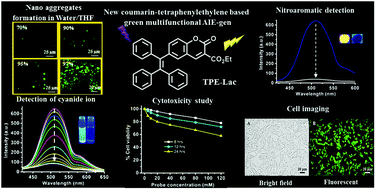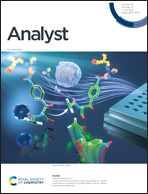A coumarin coupled tetraphenylethylene based multi-targeted AIEgen for cyanide ion and nitro explosive detection, and cellular imaging†
Abstract
A coumarin coupled tetraphenylethylene based AIEgen (TPE-Lac) with an intense greenish-yellow emission has been synthesized and utilized for multipurpose sensing and imaging applications. TPE-Lac acts as a sensitive sensor for the detection of cyanide ions (CN−) with an immediate turn-off response in the presence of many other interfering cations and anions. The limit of detection (LOD) was as low as 33 nM, which is well below the permissible limit set by the World Health Organization (WHO). Cyanide detection in the solid phase was successfully demonstrated by drop-casting the solution of the TPE-Lac probe on TLC plates and measuring and analysing the fluorescence response by ImageJ analysis. TPE-Lac was further employed in the detection of explosive nitroaromatics in solution and solid phases. Also, TPE-Lac was found suitable as an imaging agent and could easily percolate into live H520 cells giving bright fluorescence from the intra-cellular region. Easy and cost-effective synthesis, fast response and low LODs are some of the advantages of this AIEgen over available molecular probes for the same purpose.



 Please wait while we load your content...
Please wait while we load your content...